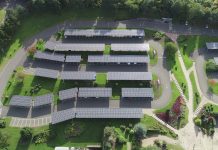Iceland’s geothermal pioneering, argues Carine Chatenay, the Marketing Manager for Verkís, has paved the way for energy independence
Iceland is nowadays considered a model for geothermal pioneering and is well-known for its exemplary utilization of geothermal resources. The country has over 90% of households heated up via the utilization of geothermal resources. What is less known to the general public is the history and the synergies that allowed this to happen.
The story of geothermal district heating in ReykjavíkThe journey started in the 1930s when visionaries had the idea to use the resources below their feet for space heating in Reykjavík. It did not go without debate and started slowly. During World War I, society had realised how dependent it was energetically. Coal prices had become so high in 1917 that the Parliament discussed the possibility to suspend school over the winter. The price of coal had been steadily increasing, becoming an ideal driver for shifting to a new source of energy.
In the early 1930s, heating up houses in Iceland was still a luxury with its set of side effects on health and safety. Reykjavík and its neighbouring communities had about 33,000 inhabitants. The area was covered with smog from coal burning. Scientists, politicians, and visionaries had been stirring the debate on geothermal for a while arguing that geothermal pioneering would be a benefit for society but still not finding a consensus on the way to proceed.
In 1930, the first milestone was achieved with the connection of a relatively large user, the primary school Austurbæjarskóli, a swimming pool and about 70 houses. The system was fed by 14 shallow wells in the vicinity of the laundry springs and produced a total of 14 l/s of 87°C water. The water was piped through a 3 km-long pipeline to the distribution system.
In 1943, a second step was taken with the implementation of the Reykjaveita main, fetching 200 l/s of 86°C hot water self-flowing from shallow wells some 17 km away from the city. About 2850 additional houses were then connected.
Geothermal district heating and policy
Much debate was still ongoing regarding geothermal district heating and a political party even advertised itself as pro-district heating as part of its campaign, promising cleaner air and a modernised indoor lifestyle. Among the measures that were taken to promote district heating was a recommendation from the city to house owners to refurbish their property or build new houses that they connect to the district heating system whenever possible.
After World war II, the population in Reykjavík and neighbouring communities started to grow rapidly, with 65.000 inhabitants in 1950. The district heating system had proven its viability, but its growth was mainly limited by the pace at which demand could be matched by supply.
Nevertheless, hot water shortages were quite common and in 1958, more wells were drilled, and well pumps were installed to boost the system’s capacity. The Reykjaveita main was also renewed thanks to a loan granted by the World Bank.
Between 1961 and 1972, the geothermal district heating in Reykjavik expanded rapidly with new neighbourhoods being developed. The new steam-driven drill rig was the turning point, and unique deep well pumps were designed, allowing for deeper and larger wells and deeper pump installation, In 1972, over 98% of Reykjavík was connected to the system. About 108.000 inhabitants lived in the area.
The oil crisis in 1973-74 then boosted more development of geothermal district heating to the neighbouring communities of Reykjavík and later, in other parts of Iceland as well. After 1990, additional heat was provided along with the production of electricity from geothermal resources.
Reykjavík and its neighbouring towns and municipalities are still expanding, and it goes without saying that every new district is to be connected to the city’s geothermal district heating. With a system relying on heat from low- temperature water-dominated fields located within the city and heat from combined heat and power plants outside the city there are challenges to covering the new demand, but it is possible to play on various parameters, at the energy source, the production and distribution systems and at the consumer level.
Takeaways for other success stories in geothermal pioneering
District heating, like any utility, is not easy to develop but presents many benefits, among other things, enabling better uptake of renewable energy and carbon reduction. Add to this equation the uncertainty related to geothermal resources, often not fully explored, and it probably explains why so few geothermal district heating systems have been developed so far despite geothermal resources being available in many ideal places where both climate and population density justify the installation of such a system.
One might say that the case of Reykjavik is not replicable because of the abundant resources within the city’s immediate perimeter. However, various conditions and measures contributed to this success story. For instance, a law was enforced in the 1960s concerning new houses that were to be systematically connected to district heating, boosting the economic feasibility of the system. Technical progress also enabled them to make better use of the geothermal resources and increase the capacity of the system with innovation in the field of deep well pumps and piping insulation.
It should be mentioned that, at the very beginning, the step consisting in connecting a large public user, nowadays a very common practice, was very efficient in strengthening the geothermal district heating project to make the prices more attractive to other smaller users who cannot be reached by any incentive.
Verkís, with its more than 60 years of geothermal district heating experience, has been consulted for technical advice and assessment of the feasibility and design of geothermal district heating in various places in the world. Despite exploitation costs varying between places, projects are in many cases found to be competitive with other conventional sources of energy. For policymakers and politicians, the barrier often remains in the lack of knowledge related to geothermal and the fear that the project may be a failure. Finance is also a barrier to this type of utility. But solutions exist and geothermal should always be investigated if available for a district heating system. The other side of the coin in such cases is a stable energy price with a local, renewable source of energy.

This work is licensed under Creative Commons Attribution-NonCommercial-NoDerivatives 4.0 International.

![image[21]](https://www.openaccessgovernment.org/wp-content/uploads/2022/12/image21-696x391.jpg)









